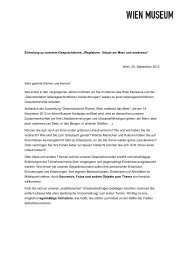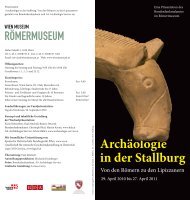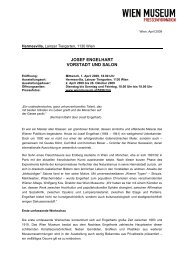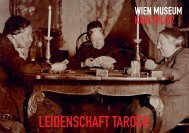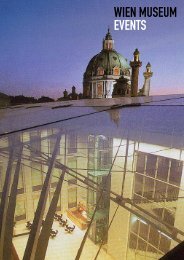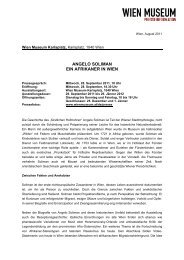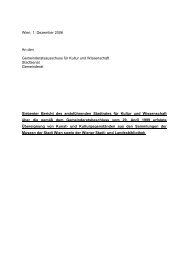the prophet the world of karl wilhelm diefenbach - Wien Museum
the prophet the world of karl wilhelm diefenbach - Wien Museum
the prophet the world of karl wilhelm diefenbach - Wien Museum
Create successful ePaper yourself
Turn your PDF publications into a flip-book with our unique Google optimized e-Paper software.
“The exhibition <strong>of</strong>fers a remarkable juxtaposition <strong>of</strong> micro and macro perspectives,” says Wolfgang<br />
Kos, Director <strong>of</strong> <strong>Wien</strong> <strong>Museum</strong>. “We get a close-up, monographic view <strong>of</strong> Diefenbach's life and work<br />
with its inherent conflicts and contradictions, but also a sweeping panorama <strong>of</strong> all <strong>the</strong> novel doctrines<br />
<strong>of</strong> salvation that were so trendy around 1900 and gave mainstream society ample opportunity for<br />
gossip and outrage. This is why we decided on <strong>the</strong> subtitle ‘The <strong>world</strong> <strong>of</strong> Karl Wilhelm Diefenbach’ for<br />
<strong>the</strong> exhibition.” Commenting on <strong>the</strong> exhibition venue, Kos points out: “Hermesvilla is located on <strong>the</strong><br />
fringes <strong>of</strong> <strong>the</strong> Vienna Woods. From here, a 20-minute walk along a footpath will get you to Himmelh<strong>of</strong>,<br />
where Diefenbach’s group <strong>of</strong> social dropouts took up residence. Originally built as a refuge where<br />
Empress Elisabeth could drift <strong>of</strong>f into a symbol-laden dream <strong>world</strong>, Hermesvilla provides a fitting<br />
genius loci for <strong>the</strong> Diefenbach exhibition.”<br />
Milestones in <strong>the</strong> life <strong>of</strong> an outsider<br />
Diefenbach was born in Hadamar, a small town in <strong>the</strong> German state <strong>of</strong> Hesse, where he grew up in a<br />
provincial Catholic household <strong>of</strong> moderate means. In 1872 he began to study painting at <strong>the</strong> Munich<br />
Academy <strong>of</strong> Fine Arts. After a severe bout <strong>of</strong> typhoid fever, Diefenbach renounced <strong>the</strong> consumption <strong>of</strong><br />
tobacco, alcohol and “lumps <strong>of</strong> animal flesh”. He engaged in free love relationships early on and left<br />
<strong>the</strong> Catholic Church (an “institute <strong>of</strong> satan”) in 1881. The following year, he married Magdalena<br />
Atzinger, with whom he already had a son; two more children were to follow. Deserting his bride on<br />
<strong>the</strong>ir wedding night, Diefenbach walked up <strong>the</strong> Hohenpeißenberg mountain in Upper Bavaria, where<br />
he experienced a spiritual awakening while watching <strong>the</strong> morning sunrise. This inspired him to pen <strong>the</strong><br />
ode Sonnen-Aufgang (“Sunrise”), a kind <strong>of</strong> literary credo in which he called upon man to “know<br />
yourself [...] God is within YOU [...] Recognise, humanity, your mo<strong>the</strong>r – NATURE”.<br />
From <strong>the</strong>n on, Diefenbach let his hair grow long, wandered <strong>the</strong> streets <strong>of</strong> Munich’s Bohemian<br />
neighbourhood Schwabing in sandals and a cowl and gave highly controversial lectures on how to live<br />
in harmony with nature. He founded his first commune in <strong>the</strong> Höllriegelskreuth quarry in 1885, where<br />
<strong>the</strong> Art Nouveau painter Hugo Höppener, alias Fidus, was one <strong>of</strong> his closest companions. Höppener<br />
also organised <strong>the</strong> first Diefenbach exhibition in Munich, but <strong>the</strong> latter’s authoritarian personality soon<br />
gave rise to serious quarrels between <strong>the</strong> two friends. Diefenbach also came under attack from<br />
government authorities on charges <strong>of</strong> “neglect <strong>of</strong> his children”, and after members <strong>of</strong> <strong>the</strong> commune<br />
were observed to be sunbathing in <strong>the</strong> nude, he had to defend himself in <strong>the</strong> first “nudist trial” in<br />
German history. On top <strong>of</strong> <strong>the</strong>se problems, his financial situation was becoming more and more<br />
untenable.<br />
A fiasco in Vienna<br />
Diefenbach <strong>the</strong>refore accepted an invitation from <strong>the</strong> Österreichischer Kunstverein, an Austrian artists’<br />
association that wanted him to supply “sensational paintings as quickly as possible” for an exhibition in<br />
Vienna – a financial rescue operation for <strong>the</strong> Kunstverein, which was on <strong>the</strong> verge <strong>of</strong> bankruptcy. The<br />
eccentric artist painted eleven large murals which, although not quite <strong>the</strong> erotic-voyeuristic stuff <strong>the</strong><br />
organisers had hoped for, managed to attract 78,000 visitors within five months. Never<strong>the</strong>less, <strong>the</strong><br />
exhibition culminated in a fiasco for Diefenbach, as Kunstverein board members embezzled money<br />
from a loan which Kunstverein had taken out using his paintings as collateral. Eventually, <strong>the</strong> ten<br />
biggest paintings were sold at auction, but Diefenbach came away empty-handed and was forced to<br />
register with <strong>the</strong> authorities as a homeless person <strong>of</strong> no means.



